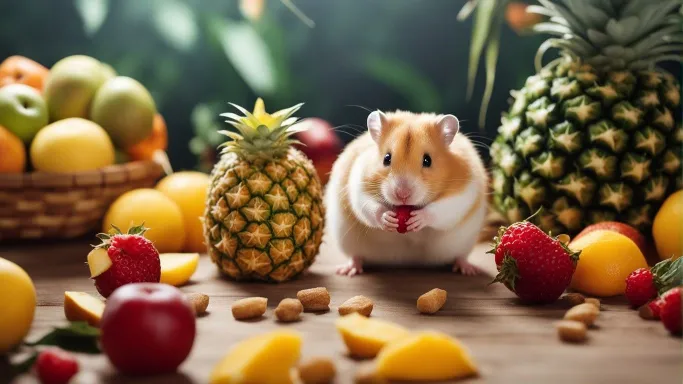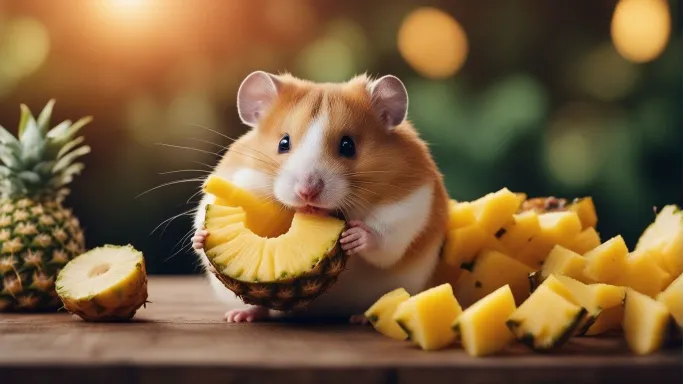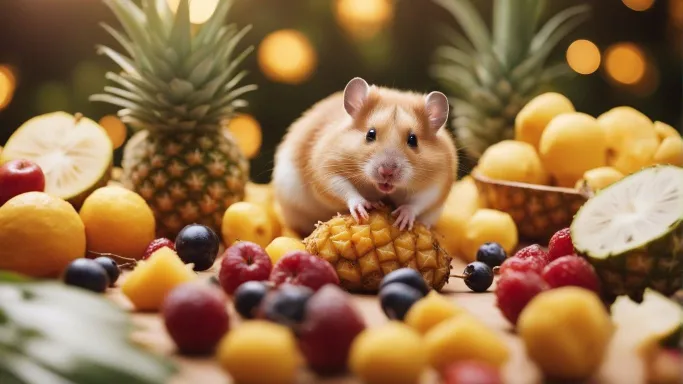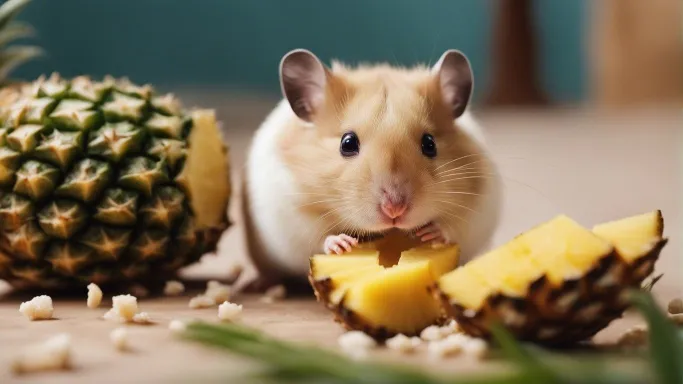If you’re wondering whether it’s safe to feed your hamster pineapple, you’ve come to the right place.
Hamsters are adorable and lovable pets, and as responsible pet owners, it’s essential to understand what we can and cannot feed them.
Pineapple, a delicious tropical fruit, may seem tempting to share with your furry friend, but is it safe?
Key Takeaways:
- Hamsters can eat pineapple, but it should be given in small quantities and not as a regular part of their diet.
- Pineapple is high in sugar and can cause weight gain, digestive issues, and nutritional imbalances if consumed in excess.
- A small piece of pineapple, about 1×1 cm in size, can be offered to hamsters once every two weeks.
- It’s important to remove the skin and core before feeding pineapple to your hamster, as they are not safe for consumption.
- Monitor your hamster closely after introducing pineapple to ensure it doesn’t develop any adverse reactions.
The Pros and Cons of Pineapple for Hamsters
Before introducing pineapple into your hamster’s diet, it’s important to understand the pros and cons of this fruity treat. Pineapple can offer some nutritional benefits, but it also comes with certain risks that need to be considered.
The Benefits of Pineapple for Hamsters
One of the main advantages of feeding pineapple to your hamster is its high vitamin C content. Vitamin C is essential for your hamster’s overall health and can boost its immune system. Pineapple also contains bromelain, an enzyme that can aid digestion and reduce inflammation.
Additionally, pineapples are a great source of fiber, which can promote healthy digestion and prevent constipation in hamsters. The natural sugars in pineapple can provide a quick energy boost for your hamster, making it an excellent treat for those active little critters.
The Risks of Pineapple for Hamsters
While pineapple has its benefits, it should be given in moderation due to its high sugar content. Hamsters have delicate digestive systems and can experience issues like diarrhea and upset stomach if they consume too much sugar. It is crucial to limit pineapple to small quantities and only offer it as an occasional treat.
Another risk to be aware of is the acidity of pineapple. Some hamsters may have more sensitive stomachs and may experience acid reflux or digestive discomfort when given pineapple. It’s essential to monitor your hamster’s reaction after introducing pineapple to its diet and consult with a veterinarian if you notice any abnormal symptoms.
| The Pros of Pineapple for Hamsters | The Cons of Pineapple for Hamsters |
|---|---|
|
|
Pineapple and Hamster Health
The health of your hamster is of utmost importance, so let’s explore how pineapple can affect its overall well-being.
Pineapple contains various vitamins and minerals, such as vitamin C and manganese, which can be beneficial for your furry friend.
However, it’s important to be cautious when feeding pineapple to hamsters due to its high sugar content.
Excessive consumption of pineapple can lead to weight gain, digestive issues, and nutritional imbalances in hamsters.
Therefore, it is recommended to offer pineapple as an occasional treat rather than a regular part of their diet.
A small piece of fresh pineapple, approximately 1×1 cm in size, given once every two weeks, is sufficient to provide some nutritional benefits without causing harm.
To ensure your hamster’s safety, it is essential to remove the skin and core of the pineapple before offering it to them.
These parts are not safe for hamsters to consume and may cause digestive problems. Always monitor your hamster after introducing pineapple into its diet to watch for any adverse reactions and adjust the amount accordingly.
| Pineapple and Hamster Health Tips: |
|---|
| • Offer pineapple as an occasional treat, not a regular part of their diet |
| • Limit the portion size to a small piece, approximately 1×1 cm in size |
| • Remove the skin and core of the pineapple before feeding it to your hamster |
| • Monitor your hamster for any adverse reactions after introducing pineapple |
Remember, a balanced diet is crucial for your hamster’s health. While pineapple can offer some nutritional benefits, it should be complemented with a variety of other fruits, vegetables, and hamster-specific pellets.
Providing a balanced diet will help ensure your hamster receives all the necessary nutrients for its well-being.

The Role of Sugar in Pineapple
Understanding the role of sugar in pineapple is crucial when considering its suitability for hamsters.
While pineapple can be a tasty treat for these small pets, it’s important to be aware of the potential risks associated with its sugar content.
High sugar intake can lead to weight gain, digestive issues, and nutritional imbalances in hamsters.
Hamsters have small digestive systems that are not designed to handle large amounts of sugar. Too much sugar can disrupt their delicate balance and potentially harm their health.
Therefore, it is essential to offer pineapple in moderation and as an occasional treat.
To give your hamster a small piece of pineapple, about 1×1 cm in size, once every two weeks provides a sweet and refreshing addition to their diet without overwhelming their system.
By limiting their intake, you can help prevent any negative effects on their weight and overall well-being.
When offering pineapple to your hamster, it is important to remove the skin and core before serving.
These parts of the pineapple are not safe for hamsters to consume and can pose a choking hazard. Always ensure that the pineapple you provide is fresh and properly prepared to protect your furry friend.
| Sugar Content in Pineapple | Benefits | Potential Risks |
|---|---|---|
| Medium to high | Rich in vitamin C, fiber, and antioxidants | Possible weight gain, digestive issues, and nutritional imbalances |
Observing your hamster after it consumes pineapple is crucial. Pay attention to any changes in their behavior, stool consistency, or appetite.
If you notice any adverse reactions, such as diarrhea or decreased activity, discontinue offering pineapple and consult a veterinarian.
While pineapple can be a tasty and tempting treat for hamsters, it should not replace their regular diet. A balanced hamster diet should consist of high-quality commercial hamster food, fresh vegetables, and occasional treats like pineapple.
Providing variety and moderation is key to ensuring your hamster’s optimal health and well-being.

Guidelines for Feeding Pineapple to Hamsters
To ensure your hamster gets the benefits of pineapple without any adverse effects, here are some guidelines for introducing this fruity treat into its diet:
- Offer small portions: Hamsters have small stomachs and can easily become overwhelmed by large amounts of pineapple. Give your hamster a small piece of pineapple, about 1×1 cm in size, to prevent digestive discomfort.
- Limit frequency: Pineapple should be given as an occasional treat rather than a regular part of your hamster’s diet. A small piece of pineapple once every two weeks is sufficient.
- Choose fresh pineapple: Always opt for fresh pineapple rather than canned or processed varieties. Fresh pineapple contains more nutrients and is less likely to contain added sugars or preservatives.
- Remove skin and core: The skin and core of pineapple are not safe for hamsters to consume. Make sure to thoroughly remove these parts before offering the pineapple to your pet.
Remember to closely monitor your hamster after introducing pineapple into its diet. Observe any changes in behavior, appetite, or digestion. If you notice any adverse reactions such as stomach upset or diarrhea, discontinue feeding pineapple immediately and consult a veterinarian.
Table 1: Guidelines for Feeding Pineapple to Hamsters
| Guidelines | Details |
|---|---|
| Portion Size | Small piece (about 1×1 cm) |
| Frequency | Once every two weeks |
| Preparation | Remove skin and core |
| Monitoring | Observe for adverse reactions |
Preparing Pineapple for Your Hamster
Before offering pineapple to your hamster, it’s important to know the correct way to prepare this tropical fruit. Pineapple should be enjoyed in moderation due to its high sugar content, which can lead to weight gain and digestive issues if consumed in excess. Follow these simple steps to safely prepare pineapple for your furry friend:
- Choose a fresh pineapple that is ripe but not overripe. Look for a pineapple with yellow skin and a sweet aroma.
- Wash the pineapple thoroughly to remove any dirt or debris.
- Using a sharp knife, carefully slice off the top and bottom of the pineapple to create a stable base.
- Stand the pineapple upright and cut off the skin in vertical strips, removing both the prickly outer layer and the eyes.
- Once the skin is removed, cut the pineapple into small, bite-sized pieces. Remember to remove the core, as it is not safe for hamsters to consume.
Now that you have prepared the pineapple, it’s time to offer it to your hamster. Remember, pineapple should only be given as an occasional treat, not as a regular part of their diet.
Start by offering a small piece, about 1×1 cm in size, and observe your hamster’s reaction. If any adverse effects occur, such as diarrhea or changes in behavior, discontinue feeding pineapple and consult a veterinarian.
By following these guidelines, you can safely introduce pineapple as an occasional treat for your hamster, providing them with a variety of flavors and textures in their diet.
Remember to always prioritize your hamster’s well-being and consult a professional if you have any concerns.
| Pineapple Preparation Steps: |
|---|
| 1. Choose a fresh, ripe pineapple. |
| 2. Wash the pineapple thoroughly. |
| 3. Cut off the top and bottom of the pineapple. |
| 4. Remove the skin in vertical strips, removing both the prickly outer layer and the eyes. |
| 5. Cut the pineapple into small, bite-sized pieces, removing the core. |
Monitoring Your Hamster’s Reaction to Pineapple
It’s crucial to keep a close eye on your hamster’s well-being after introducing pineapple to its diet. While pineapple can be enjoyed by hamsters in small quantities, it’s important to monitor their reaction to ensure they tolerate it well. Here are some key indicators to watch for:
- Changes in appetite: Pay attention to any significant decrease or increase in your hamster’s appetite after consuming pineapple. A sudden loss of interest in food or a sudden increase in appetite could indicate a negative reaction.
- Digestive issues: Keep an eye out for any signs of digestive problems, such as diarrhea or constipation. Pineapple contains enzymes that can affect a hamster’s digestive system, so it’s important to watch for any irregularities or discomfort.
- Behavioral changes: Observe your hamster’s behavior for any unusual changes, such as lethargy, restlessness, or aggression. These could be signs of discomfort or distress.
If you notice any of these symptoms, it’s important to stop feeding pineapple to your hamster and consult a veterinarian if necessary. Every hamster is unique, and while some may tolerate pineapple well, others may have adverse reactions. Remember to always introduce new foods gradually and in small amounts to minimize the risk of any digestive issues.
| Signs of a Positive Reaction | Signs of a Negative Reaction |
|---|---|
| “Chirping” or happy vocalization | Loss of appetite |
| Increased activity and playfulness | Diarrhea or constipation |
| Normal and healthy digestion | Behavioral changes (lethargy, aggression) |
“Remember to always introduce new foods gradually and in small amounts to minimize the risk of any digestive issues.”
By closely monitoring your hamster’s reaction to pineapple, you can ensure its safety and well-being. If your hamster shows positive indicators, such as a healthy appetite, normal digestion, and increased activity, you can continue offering pineapple as an occasional treat. However, if you notice any negative reactions, it’s best to avoid feeding pineapple to your furry friend in the future and seek guidance from a veterinarian.
Overall, while pineapple can be a tasty and nutritious addition to a hamster’s diet when given in moderation, it’s essential to prioritize their health and well-being by carefully monitoring their reaction to this tropical fruit.

Alternatives to Pineapple for Hamsters
If you’re looking for alternative treats for your hamster, there are plenty of other options to consider apart from pineapple. While pineapple can be given in moderation, it’s important to provide a diverse diet to ensure your furry friend gets all the necessary nutrients. Here are some safe and healthy alternatives to pineapple:
- Apples: A slice of apple, without the seeds or core, can be a tasty and nutritious treat for your hamster. Apples are a good source of vitamins and fiber.
- Carrots: Hamsters love carrots! They are crunchy and low in sugar, making them a great option for snacking. Just make sure to wash and peel the carrots before offering them to your hamster.
- Blueberries: These small fruits are packed with antioxidants and can be a delicious treat for your hamster. Offer a few blueberries as an occasional sweet treat.
- Cucumbers: Cucumbers are hydrating and low in calories, making them a healthy option for hamsters. Slice up some cucumber and watch your hamster enjoy the refreshing snack.
Remember to introduce new foods gradually and observe how your hamster reacts to them. Each hamster may have different preferences and tolerances, so it’s important to pay attention to their individual needs. Provide a varied diet that includes a mix of fruits, vegetables, and hamster pellets to ensure your hamster stays happy and healthy.
| Food | Serving Size | Frequency |
|---|---|---|
| Apple | 1 slice without seeds or core | Once a week |
| Carrot | 1 small piece | A few times a week |
| Blueberries | A few berries | Once a week |
| Cucumber | A few slices | A few times a week |
“Offering a variety of foods is essential for your hamster’s overall health and well-being. By providing different treats, you can keep your hamster excited about mealtime and ensure they receive a balanced diet.”
The Importance of a Balanced Hamster Diet
While pineapple can be a tasty addition to your hamster’s diet, it’s important to remember that balance is key for its overall well-being. Hamsters, like any other pet, require a diverse and nutritious diet to thrive. Providing a variety of foods ensures that your hamster receives all the essential nutrients it needs to maintain its health.
When it comes to pineapple, it should be offered to your hamster sparingly. Pineapple is high in sugar, which can lead to weight gain and digestive issues if consumed in excess. It is recommended to give your hamster a small piece of fresh pineapple, about 1×1 cm in size, no more than once every two weeks.
To ensure your hamster’s safety, it’s crucial to remove the skin and core of the pineapple before offering it. These parts are not safe for hamsters to consume and can pose a choking hazard. By providing properly prepared pineapple, you can minimize the risk of any potential harm to your furry friend.
| The Role of Pineapple in a Balanced Hamster Diet | |
|---|---|
| Benefits | Risks |
|
|
While pineapple can offer some nutritional benefits to your hamster, it should never substitute the main components of its diet. A balanced hamster diet consists of high-quality hamster pellets as the staple food, supplemented with fresh vegetables, fruits, and occasional treats like pineapple. This variety ensures that your hamster receives a well-rounded diet that meets all its nutritional requirements.
Observing your hamster after introducing pineapple is crucial. Watch for any adverse reactions such as changes in appetite, behavior, or the development of diarrhea. If you notice any negative effects, it’s best to discontinue offering pineapple and consult with a veterinarian. Every hamster is unique, and their dietary needs may vary, so it’s essential to consider your hamster’s individual health and well-being when deciding on any dietary changes.
Conclusion
In conclusion, hamsters can safely eat pineapple, but it should only be given in small quantities, following specific guidelines, to avoid potential health issues.
Pineapple is high in sugar, which can lead to weight gain and digestive problems in hamsters if consumed excessively. Therefore, it is important to limit the amount of pineapple given to your furry friend.
When offering pineapple to your hamster, make sure to remove the skin and core, as they are not safe for consumption. Cut a small piece of pineapple, about 1×1 cm in size, and offer it once every two weeks as a treat.
After introducing pineapple to your hamster’s diet, carefully observe their reaction. Watch for any signs of discomfort, such as diarrhea or changes in appetite. If any adverse effects occur, discontinue feeding pineapple and consult a veterinarian.
Remember, a balanced diet is crucial for your hamster’s overall health. While pineapple can be a tasty and nutritious treat, it should not replace their regular food and should always be given in moderation.
FAQ
Q: Can hamsters eat pineapple?
A: Yes, hamsters can eat pineapple, but it should only be given in small quantities and not as a regular part of their diet.
Q: How much pineapple can I give to my hamster?
A: Hamsters should only be given a small piece of pineapple, about 1×1 cm in size, once every two weeks.
Q: What parts of the pineapple are safe for hamsters to eat?
A: Only the flesh of the pineapple is safe for hamsters to consume. The skin and core should be removed and not given to your hamster.
Q: What are the potential risks of feeding pineapple to hamsters?
A: Pineapple is high in sugar and can cause weight gain, digestive issues, and nutritional imbalances if consumed in excess.
Q: How should I monitor my hamster after introducing pineapple to its diet?
A: It is important to observe your hamster after it consumes pineapple and look for any adverse reactions. If your hamster shows any signs of discomfort or unusual behavior, consult a veterinarian.
Q: Can I offer any alternatives to pineapple for my hamster?
A: Yes, there are various other treats and fruits that you can offer to your hamster to diversify its diet. Some options include apples, strawberries, and carrots. However, always introduce new foods gradually to avoid digestive upset.
Q: Why is a balanced diet important for hamsters?
A: A balanced diet is crucial for the overall health and well-being of hamsters. It ensures they receive the necessary nutrients and prevents nutritional deficiencies or imbalances.




